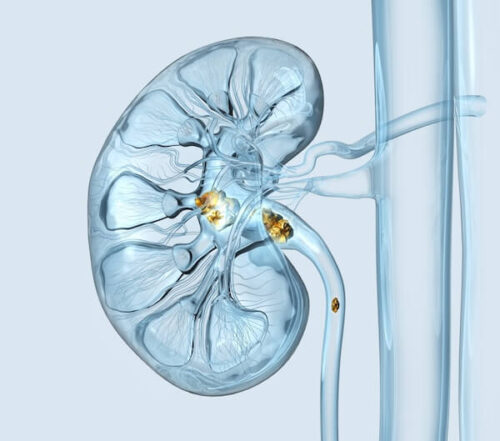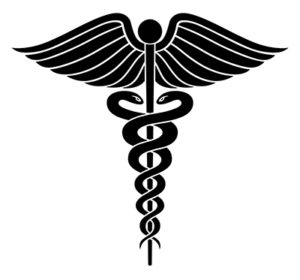Prostate Trouble: Steps to Improving the Flow
The prostate, a gland the size and shape of a kiwifruit, is hidden from sight within the lower pelvis of a boy and a man, causing no notice until the later years of life. With the onset of puberty, male hormones, especially dihydrotestosterone, cause the prostate gland to grow and produce a slightly alkaline white fluid within which sperm live and swim until ejaculated through the urethra. This short tube, the urethra, passes from the bladder through the prostate gland and then into the penis. Overgrowth of this gland’s cells as a man ages constricts the urethra and results in problems in passing urine.
Constriction of the urethra causes urgency, a weak stream, dribbling, hesitancy, and frequent urination during the day and at night. The condition is called ‘benign prostatic hyperplasia,’ abbreviated BPH. (Hyperplasia is a condition in which there is an increase in the number of normal cells but is not cancer.) Estimates are that 50 percent of men by 50 years of age, 60 percent by age 60, and as high as 80 percent by age 70 have clinically significant prostate hyperplasia. By age 80 nearly one man in four has undergone some type of surgery to relieve symptoms. When symptoms become sufficiently troublesome that they interfere with a man’s enjoyment of life then something needs to be done.
The Western Diet Causes BPH
Decades of overstimulation of the prostate, due to an excess of growth hormones (like IGF-1) and male hormones, causes an overgrowth of cells of the prostate gland. The over-consumption of dietary protein causes IGF-1 levels to rise. This means that beef, pork, chicken, turkey, fish, cheese, and milk increase IGF-1 levels. Even vegetarians need to be careful because isolated soy proteins, like those found in fake soy meats and cheeses, have a powerful effect on raising IGF-1 levels. The intake of dietary fat and fiber (which is found only in plant foods) has a major influence on sex hormones, including estrogen and testosterone. A low-fat, high-fiber diet decreases prostate-growth-stimulating male hormones. Furthermore, a healthy low-fat, starch-based diet and daily aerobic exercise reverses all hormone imbalances and excesses, preventing the development of BPH.
A recent study comparing two populations of Chinese men (Han and Mongolian) found BPH to be almost twice as common in the Mongolians, who consumed more meat and dairy, than in the Hans. An article in the April 2002 issue of the American Journal of Clinical Nutrition found a causal association between BPH and the intake of more calories, total protein, animal protein, and vegetable fat. Data on 51,529 men in the Health Professionals Follow-up Study was used for this study. A study from Greece showed that an increase in butter and margarine increases the risk of BPH and that fruit intake reduces this risk.
Treating BPH with Diet
The scientific evidence shows that a healthy, low-fat, starch-based diet will prevent benign prostate hyperplasia. Furthermore, a healthy diet will lower prostate-growth-stimulating male hormones in men. Medications that reduce the effects of these same male hormones (such as finasteride, also known as Proscar and Propecia) have been shown to produce long-term symptomatic improvement, and to reduce the risk of urinary retention and the need for surgery in men with BPH. Unfortunately, there have been few studies showing the direct benefits of a healthy diet on improving the lives of men with BPH.
Since abdominal obesity puts pressure on the bladder, weight loss can help relieve bladder symptoms. Toward this, diet and exercise will help. A small pilot study involving 15 men explored the effects of a flaxseed-supplemented, fat-restricted diet on the cellular proliferation rates in the prostate. The men followed a low-fat diet (with fewer than 20 percent of the calories coming from fat for six months). A flaxseed supplement (30 g/day) was also added. Cholesterol and PSA levels decreased and there was no decrease in total testosterone. Of the 13 men who underwent repeat biopsy, the proliferation rates of the prostate cells decreased significantly.
My experience with men having BPH has been mixed. I have seen some men improve their urination after changing to the McDougall diet, but I have also seen men with BPH, especially once it has advanced, fail to respond to the low-fat, high-fiber, male hormone-correcting McDougall diet. These men have sometimes required further help.
The First Steps in Treating BPH
The decision to treat BPH should be guided by the severity of the symptoms. In other words, passage of the urine must be sufficiently troublesome for the man to want to have something done. This is an individual choice left to the well-informed patient.
However, there are some simple things that can be tried before taking more drastic steps. Restrict fluids, particularly prior to bedtime, which will help relieve the need to urinate at night. Avoid caffeinated beverages (coffee, colas and tea), which will help reduce the frequency of urination. Avoid alcoholic beverages and spicy foods, which can cause an increased excretion of urine (a diuresis). Get off of medications, especially diuretics that are commonly used to treat high blood pressure and cause frequent urination. In addition, discontinuing decongestants, antihistamines, and antidepressants that can interfere with the ability to pass the urine easily can be helpful. In general, any medication a man is taking should be suspect for causing problems with urination, and the patient and his doctor should consider a trial without medication when appropriate.
Natural Remedies Should Be Tried
Zinc Must Be Avoided
Zinc is commonly recommended for prostate health because the prostate contains the highest concentration of zinc of all the soft tissues. High-dose zinc supplements used in the treatment of age-related macular degeneration were found to increase the risk for BPH, kidney stones, urinary tract infection, and kidney failure. Other large epidemiologic studies have found a potential relation between high-dose zinc from diet (meat) or supplements, and an increased risk for BPH and aggressive prostate cancer. Zinc is also associated with an increased risk of heart disease.
Saw Palmetto Seems Effective
Approximately 2.5 million men in the United States use saw palmetto extract, one of the top 10 best selling herbal supplements around the world. The extract from the saw palmetto plant, Serenoa repens, has been tested in many studies. Based on a Cochrane Review this pharmacologically active extract was not more effective than placebo for treatment of urinary symptoms from BPH. However, a review in the Journal of the American Medical Association came to a different conclusion, with the evidence suggesting that saw palmetto improves urologic symptoms and flow measures. This herb was found to be as effective as prescription medication (finasteride) but with fewer adverse side events.
Pygeum Will Be Effective
Pygeum africanum, the extract of the African prune tree, improves urologic symptoms and flows of men with BPH. Men using Pygeum africanum were more than twice as likely to report an improvement in overall symptoms; nighttime urination (nocturia) was reduced by 19%, residual urine volume by 24% and peak urine flow was increased by 23%. Adverse effects due to Pygeum africanum were mild and comparable to placebo. Another review in the American Journal of Medicine found evidence that P. africanum modestly, but significantly, improves urologic symptoms and flow measures.
Cernilton for BPH.
Cernilton is a pollen extract from rye and has shown improvements for ‘self rated urinary symptoms’ (percent reporting satisfactory or improving symptoms) compared to a placebo. Cernilton reduced nocturia but did not improve urinary flow rates, residual volume, or prostate size compared to placebo.
Plant Sterols Help
Beta-sitosterol is one kind of many different sterols found in plants and has been used to inhibit the absorption of cholesterol from the intestine. In Europe it has also been used for the treatment of BPH. A Cochrane Review found that Beta-sitosterol improved urinary symptom scores and flow measures. B-sitosterol did not reduce prostate size.
A Visit to the Doctor
When the symptoms have become too troublesome to tolerate, a journey to a general doctor, such as a family practitioner or an internist (not to a specialist urologist) should be made. A history, including a medication history, and a physical examination, including digital rectal exam, are part of the basic evaluation for a man with suspected BPH. The PSA (prostate-specific antigen) test is often done for an assessment of prostate volume. However, caution should be heeded because this unreliable test often leads to a pursuit of the diagnosis of prostate cancer as well as the horrible tests and treatments that follow, all of which cause suffering and fail to prolong life. Be prepared to say ‘no’ to further testing, including a biopsy, if the PSA is elevated.
A urinalysis (routine and microscopic) should be done. A finding of blood in the urine is common with BPH.
Prescription Drugs for BPH
Alpha adrenoceptor blockers (antagonists), such as doxazosin, terazosin, alfuzosin, and tamsulosin, improve symptoms and peak urine flow of patients with BPH. The mechanism of action is unknown but doctors believe this medication relaxes the smooth muscles surrounding the urethra and at the bladder neck. These medications do not alter the natural progression of the disease (BPH).
The alpha-reductase inhibitors (dutasteride and finasteride) are drugs that have an anti-androgen (male hormone) effect. They inhibit the conversion of testosterone to the active form of dihydrotestosterone. When the hormone levels decrease, there may also be a decrease in the size of the prostate gland. These medications are effective in relieving the symptoms of BPH in some patients.
The Last Step: The Urologist
If, after trying any and all of the above conservative measures, symptoms still persist, then a mechanical procedure to reduce the restriction of urine flow is the next step. Look to a surgeon, a urologist, when you cannot take it anymore. There are three procedures that are considered minimally invasive: transurethral microwave thermotherapy (TUMT), transurethral needle ablation (TUNA), and transrectal high intensity focused ultrasound (HIFU). All use heat produced by microwave or ultrasound to cause some of the prostate tissue to die and shrink away from the urethra, thereby increasing the size of the passageway for the urine. All three are office procedures considered equally effective and relatively safe. These should be looked into first before considering more radical surgeries such as laser prostatectomy, transurethral resection of the prostate (TURP), or open prostatectomy (abdominal surgery). The kind of treatment you will be offered will depend, to a large extent, on the preference of the urologist you see. Therefore, it is very important to get several opinions before proceeding with any of these six kinds of invasive therapies.
References:
1) Axelsson I. Effects of high protein intakes. Nestle Nutr Workshop Ser Pediatr Program. 2006;58:121-9.
2) Melnik B. Milk consumption: aggravating factor of acne and promoter of chronic diseases of Western societies. J Dtsch Dermatol Ges. 2009 Apr;7(4):364-70.
3) Arjmandi BH, Khalil DA, Smith BJ, Lucas EA, Juma S, Payton ME, Wild RA. Soy protein has a greater effect on bone in postmenopausal women not on hormone replacement therapy, as evidenced by reducing bone resorption and urinary calcium excretion. J Clin Endocrinol Metab. 2003 Mar;88(3):1048-54.
4) Wu AH, Pike MC, Stram DO. Meta-analysis: dietary fat intake, serum estrogen levels, and the risk of breast cancer. J Natl Cancer Inst. 1999 Mar 17;91(6):529-34.
5) Bagga D, Ashley JM, Geffrey SP, Wang HJ, Barnard RJ, Korenman S, Heber D. Effects of a very low fat, high fiber diet on serum hormones and menstrual function. Implications for breast cancer prevention. Cancer. 1995 Dec 15;76(12):2491-6.
6) Wang C, Catlin DH, Starcevic B, Heber D, Ambler C, Berman N et al: Low-fat high-fiber diet decreased serum and urine androgens in men. J Clin Endocrinol Metab 2005; 90: 3550.
7) Thompson IM. Chemoprevention of prostate cancer: agents and study designs. J Urol. 2007 Sep;178(3 Pt 2):S9-S13.
10) Dorgan JF, Judd JT, Longcope C, Brown C, Schatzkin A, Clevidence BA, Campbell WS, Nair PP, Franz C, Kahle L, Taylor PR 1996 Effects of dietary fat and fiber on plasma and urine androgens and estrogens in men: a controlled feeding study. Am J Clin Nutr 64:850-5
11) Reed MJ, Cheng RW, Simmonds M, Richmond W, James VH 1987 Dietary lipids: an additional regulator of plasma levels of sex hormone binding globulin. J Clin Endocrinol Metab 64:1083╨1085
12) Hamalainen E, Adlercreutz H, Puska P, Pietinen P 1984 Diet and serum sex hormones in healthy men. J Steroid Biochem 20:459-464.
13) Wang C, Catlin DH, Starcevic B, Heber D, Ambler C, Berman N, Lucas G, Leung A, Schramm K, Lee PW, Hull L, Swerdloff RS 2005 Low-fat high-fiber diet decreased serum and urine androgens in men. J Clin Endocrinol Metab 90:3550-3559.
14) Allen NE, Appleby PN, Davey GK, Key TJ. Hormones and diet: low insulin-like growth factor-I but normal bioavailable androgens in vegan men. British Journal of Cancer (2000) 83(1), 95-97.
15) Barnard RJ, Aronson WJ. Benign prostatic hyperplasia: does lifestyle play a role? Phys Sportsmed. 2009 Dec;37(4):141-6.
16) Wang YB, Xie LP, Yuan YG, Zheng XY, Qin J. Differences in the risk factors for clinical benign prostatic hyperplasia between the Mongolian and the Han people] Zhonghua Nan Ke Xue. 2007 Jan;13(1):33-6.
17) Suzuki S. Intakes of energy and macronutrients and the risk of benign prostatic hyperplasia. Am J Clin Nutr. 2002 Apr;75(4):689-97.
18) Lagiou P, Wuu J, Trichopoulou A, Hsieh CC, Adami HO, Trichopoulos D. Diet and benign prostatic hyperplasia: a study in Greece. Urology. 1999 Aug;54(2):284-90.
19) Marberger MJ. Long-term effects of finasteride in patients with benign prostatic hyperplasia: a double-blind, placebo-controlled, multicenter study. PROWESS Study Group. Urology. 1998 May;51(5):677-86.
20) Demark-Wahnefried W, Robertson CN, Walther PJ, Polascik TJ, Paulson DF, Vollmer RT. Pilot study to explore effects of low-fat, flaxseed-supplemented diet on proliferation of benign prostatic epithelium and prostate-specific antigen. Urology. 2004 May;63(5):900-4.
21) Ho E, Song Y. Zinc and prostatic cancer. Curr Opin Clin Nutr Metab Care. 2009 Nov;12(6):640-5.
22) Age-Related Eye Disease Study Research Group. A randomized, placebo-controlled, clinical trial of high-dose supplementation with vitamins C and E, beta-carotene, and zinc for age-related macular degeneration and vision loss: AREDS Report Number 8. Arch Ophthalmol. 2001;119:1417-1436.
23) Johnson AR, Munoz A, Gottlieb JL, Jarrard DF. High dose zinc increases hospital admissions due to genitourinary complications. J Urol. 2007;177:639-643.
24) Leitzmann MF, Stampfer MJ, Wu K, Colditz GA, Willett WC, Giovannucci EL. Zinc supplement use and risk of prostate cancer. J Natl Cancer Inst. 2003;95:1004-1007.
25) Moyad MA. Zinc for prostate disease and other conditions: a little evidence, a lot of hype, and a significant potential problem. Urol Nurs. 2004;24:49-52.
26) Ernst E. The risk-benefit profile of commonly used herbal therapies: ginkgo, St. John’s wort, ginseng, echinacea, saw palmetto, and kava. Ann Intern Med. 2002;136:42-53.
27) Tacklind J, MacDonald R, Rutks I, Wilt TJ. Serenoa repens for benign prostatic hyperplasia. Cochrane Database Syst Rev. 2009 Apr 15;(2):CD001423.
28) Wilt TJ, Ishani A, Stark G, MacDonald R, Lau J, Mulrow C. Saw palmetto extracts for treatment of benign prostatic hyperplasia: a systematic review.
JAMA. 1998 Nov 11;280(18):1604-9.
29) Wilt T, Ishani A, Mac Donald R, Rutks I, Stark G. Pygeum africanum for benign prostatic hyperplasia. Cochrane Database Syst Rev. 2002;(1):CD001044.
30) Ishani A, MacDonald R, Nelson D, Rutks I, Wilt TJ. Pygeum africanum for the treatment of patients with benign prostatic hyperplasia: a systematic review and quantitative meta-analysis. Am J Med. 2000 Dec 1;109(8):654-64.
31) Wilt T, Mac Donald R, Ishani A, Rutks I, Stark G.Cernilton for benign prostatic hyperplasia. Cochrane Database Syst Rev. 2000;(2):CD001042.
32) Wilt T, Ishani A, MacDonald R, Stark G, Mulrow C, Lau J. Beta-sitosterols for benign prostatic hyperplasia. Cochrane Database Syst Rev. 2000;(2):CD001043.
33) Wilt TJ, Mac Donald R, Rutks I. Tamsulosin for benign prostatic hyperplasia. Cochrane Database Syst Rev. 2003;(1):CD002081
34) Wilt TJ, Howe RW, Rutks IR, MacDonald R.Terazosin for benign prostatic hyperplasia. Cochrane Database Syst Rev. 2002;(4):CD003851.
35) Hoffman RM, Monga M, Elliot SP, Macdonald R, Wilt TJ. Microwave thermotherapy for benign prostatic hyperplasia. Cochrane Database Syst Rev. 2007 Oct 17;(4):CD004135.
36) Ohigashi T, Nakamura K, Nakashima J, Baba S, Murai M. Long-term results of three different minimally invasive therapies for lower urinary tract symptoms due to benign prostatic hyperplasia: comparison at a single institute. Int J Urol. 2007 Apr;14(4):326-30.
Recommended Articles

The Truth About Oxalates & Kidney Stones

Working with MDs






